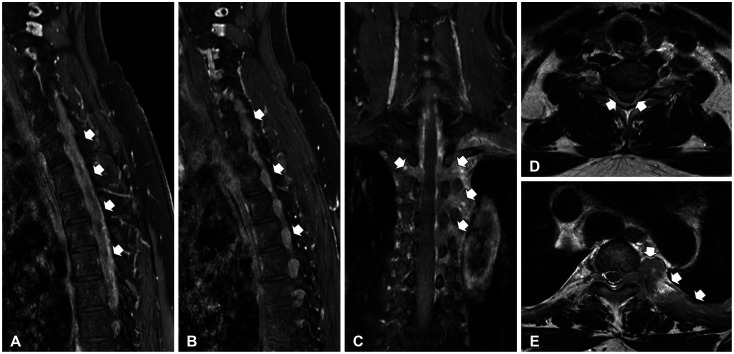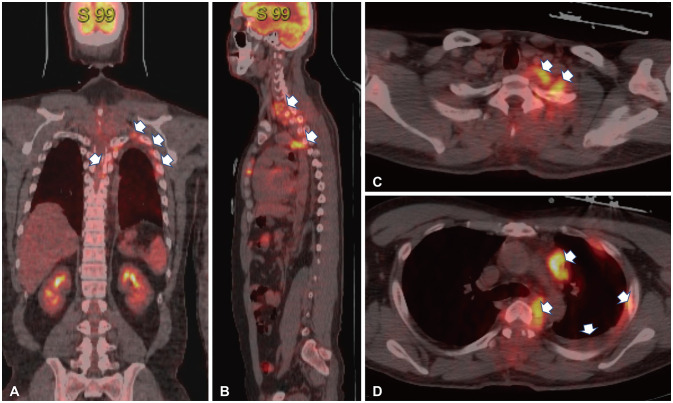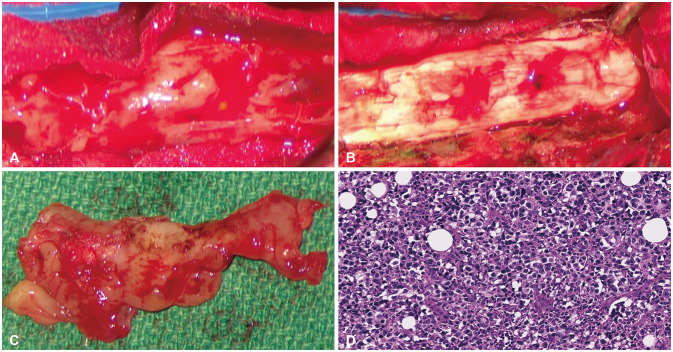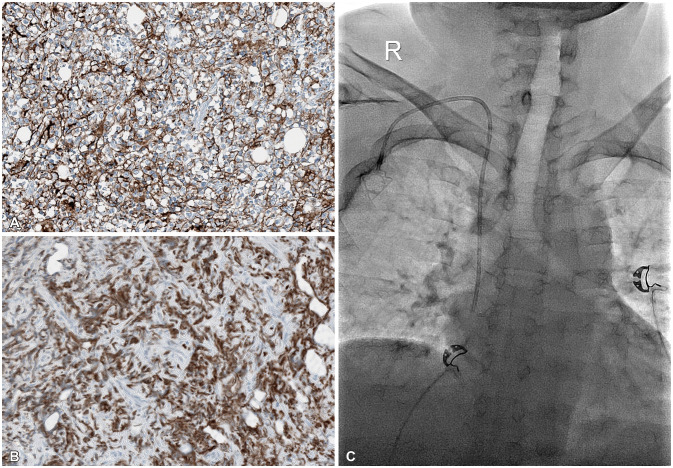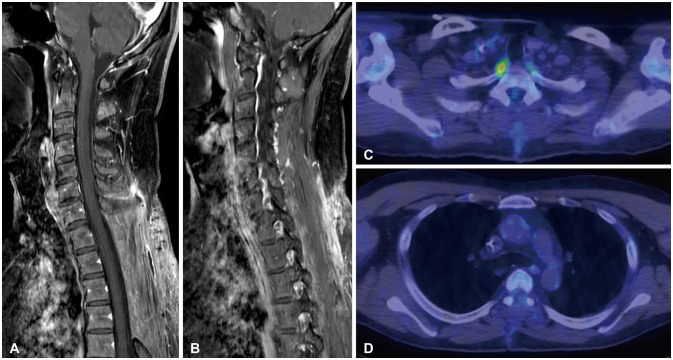Brain Tumor Res Treat.
2023 Jan;11(1):66-72. 10.14791/btrt.2022.0038.
A Rare Occurrence of Primarily Extranodal Spinal Epidural Lymphoma With Spinal Cord Compression and Invasion to the Thoracic Cavity
- Affiliations
-
- 1Department of Neurosurgery, Neuroscience & Radiosurgery Hybrid Research Center, Inje University Ilsan Paik Hospital, College of Medicine, Goyang, Korea
- 2Department of Pathology, Inje University Ilsan Paik Hospital, College of Medicine, Goyang, Korea
- KMID: 2539331
- DOI: http://doi.org/10.14791/btrt.2022.0038
Abstract
- A 41-year-old man suffered from progressive radiculomyelopathy caused by spinal epidural mass primarily encasing the spinal cord at the cervicothoracic vertebrae that extended into the thoracic cavity through the neural foramen. An urgent decompressive laminectomy and epidural tumor resection were performed to prevent neurological deterioration and effective spinal cord decompression. The histopathologic diagnosis was diffuse large B-cell lymphoma. As first-line treatment for stage II extranodal lymphoma, he received 6 cycles of R-CHOP (rituximab/cyclophosphamide, hydroxydaunorubicin, Oncovin, and prednisone) chemotherapy. Consequently, follow-up positron-emission tomography CT and MR images demonstrated a complete metabolic response (Deauville score 1). This rare occurrence of primarily extranodal spinal epidural lymphoma with limited disease will be presented in a literature review.
Keyword
Figure
Reference
-
1. Hashi S, Goodwin CR, Ahmed AK, Sciubba DM. Management of extranodal lymphoma of the spine: a study of 30 patients. CNS Oncol. 2018; 7:CNS11. PMID: 29706086.
Article2. Siegel RL, Miller KD, Fuchs HE, Jemal A. Cancer statistics, 2022. CA Cancer J Clin. 2022; 72:7–33. PMID: 35020204.
Article3. Uehara M, Takahashi J, Hirabayashi H, Kitahara J, Kamijyo T, Ebara S, et al. Hodgkin’s disease of the thoracic vertebrae. Spine J. 2013; 13:e59–e63.
Article4. Koeller KK, Shih RY. Extranodal lymphoma of the central nervous system and spine. Radiol Clin North Am. 2016; 54:649–671. PMID: 27265601.
Article5. Cugati G, Singh M, Pande A, Ramamurthi R, Balasubramanyam M, Sethi SK, et al. Primary spinal epidural lymphomas. J Craniovertebr Junction Spine. 2011; 2:3–11. PMID: 22013369.
Article6. Özdemir NG, Baran Ö, Şahin ÖF, Akbaş F, Köker HT, Huq GE. Primary spinal epidural lymphoma: a case report. Istanb Med J. 2020; 21:32–35.
Article7. Mally R, Sharma M, Khan S, Velho V. Primary lumbo-sacral spinal epidural non-Hodgkin’s lymphoma: a case report and review of literature. Asian Spine J. 2011; 5:192–195. PMID: 21892393.
Article8. Monnard V, Sun A, Epelbaum R, Poortmans P, Miller RC, Verschueren T, et al. Primary spinal epidural lymphoma: patients’ profile, outcome, and prognostic factors: a multicenter rare cancer network study. Int J Radiat Oncol Biol Phys. 2006; 65:817–823. PMID: 16542791.
Article9. Xiong L, Liao LM, Ding JW, Zhang ZL, Liu AW, Huang L. Clinicopathologic characteristics and prognostic factors for primary spinal epidural lymphoma: report on 36 Chinese patients and review of the literature. BMC Cancer. 2017; 17:131. PMID: 28196505.
Article10. Park SH, Whang CJ, Sohn M, Oh YC, Lee CH, Whang YJ. Idiopathic hypertrophic spinal pachymeningitis: a case report. J Korean Med Sci. 2001; 16:683–688. PMID: 11641545.
Article11. Luo CC. Spinal cord compression secondary to metastatic non-Hodgkins lymphoma: a case report. Arch Phys Med Rehabil. 2005; 86:332–334. PMID: 15706563.
Article12. Yáñez ML, Miller JJ, Batchelor TT. Diagnosis and treatment of epidural metastases. Cancer. 2017; 123:1106–1114. PMID: 28026861.
Article13. Jagtap S, Patil A, Kesavdas C, Radhakrishnan N, Soni H, Satish K. Primary spinal epidural diffuse large B-cell lymphoma. Neurol India. 2013; 61:532–534. PMID: 24262463.
Article
- Full Text Links
- Actions
-
Cited
- CITED
-
- Close
- Share
- Similar articles
-
- Primary Spinal Epidural Lymphoma Mimicking Epidural Abscess in a Diabetic
- Thoracic Actinomycosis Causing Spinal Cord Compression
- Epidural Lymphoma Mimicking Hematoma: A Case Report
- Simultaneous Occurrence of Hodgkin's Lymphoma and Langerhans Cell Histiocytosis of the Spine : A Rare Combination
- A Case of Spontaneous Cervical Spinal Epidural Hematoma: Case Report

